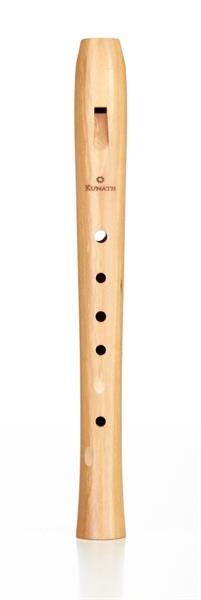KUNATH pentatonic Siebentonfl÷te 432 Hz grip
Ready to ship today,
Delivery time appr. 1-3 workdays
- Order number: kun51061
- Purchase Unit: Stck.
The Sun Recorder (Die Sonnenfloete)
The idea of the Sun Recorders came to me after I had been working with the pentatonic scale (a five note system) for about 14 years. This system was suggested by Rudolf Steiner for small children up to the age of about nine. When small children sing to themselves, they often use the series of notes which a musicologist would describe as pentatonic.
An example of the pentatonic scale is when you only play the black notes on the piano. It is typical for this scale that there are no semitone steps. We are generally used to seven different notes (diatonic) with semitones. If you compare a pentatonic and diatonic melody, listening intensively, you find that the pentatonic melody is freer and more open whereas the diatonic melody is more rigid. The pentatonic melodies are, so to say, closer to the open sky, the cosmos, than the diatonic melodies. This explains why small children are more drawn to pentatonic melodies than diatonic melodies in flat or sharp keys. Small children are not so set in their ways and still open to the cosmos; unlike adults who tend to be more earthbound.
By only using the notes D, E, G, A and B, the range recommended by Rudolf Steiner for small children, you can play a pentatonic scale with the white keys on the piano.
How is the pentatonic scale structured?
If you position the notes d,e,g,a and b in fifths one above the other you get the sequence G, D, A, E, B, with A in the centre. If you place the notes D, E, G, A, B in a circle and draw a line connecting G and D then a line connecting A, E and B you form a pentagon with the note A at the top. The note A clearly has a central role within the pentatonic scale. This becomes even more obvious when the notes are grouped closely together and you examine the intervals starting from A. The intervals are mirrored. From A up you find a major second followed by a minor third and from A down you have the same. It is only starting from A that this mirroring occurs; it does not work if you take another note as your starting point. This phenomenon confirms our belief that the note A has a special importance within the pentatonic scale.
Rudolf Steiner attributed each of the seven notes to a planet:
He attributed the notes like this:
E with Jupiter
G with Saturn
A with the Sun
B with the Moon
D with Mercury
(Here the Sun and the Moon are considered as planets.)
It is clear that the five pentatonic notes E, G, A, B and D form a Sun scale centred around A, the note attributed to the Sun.
In this way, we can see why Rudolf Steiner chose these notes in particular. This thinking can be reflected in the way the notes are used in a song.
For example:
Starting with A you can play around the note before returning to it at the end. In this way the sunny quality of the notes is stongly emphasized.
Using my experience in this field, I developed a recorder for six-year-olds, which could be played without difficulty (the tonal sequence is E, G, A, B, and D). The lowest note is E and the highest is D, with the Sun note of A in the middle (the recorder has no thumb hole). As six-year-olds still have high voices, the tonal range is also good for singing.
Another factor in the development of this instrument was Rudolf Steiner’s recommendation that C should have a pitch of 128 Hz. This means that A should have an oscillation frequency of 432Hz. This pitch is lower than that usually used in music today. Tonal sequences based on C =128Hz respectively A= 432 Hz can have a therapeutic influence.
I found that this pitch had a very beneficial influence when working with eurythmic groups. In contrast, when I played a piano tuned to A=440Hz I noticed that children and teenagers who were slightly excited when they came to the music lesson tended to become more agitated. When I then played an instrument tuned lower, the children became calmer. A pitch based on C=128Hz allows you to breathe freely, while a tonal sequence based on A=440Hz cramps you and prevents you from breathing freely.
This pitch has also proved to be advantageous when singing; it is simply easier to sing. In her book “Of Notes, Scales and the Standard Pitch A” Ms. Maria Renold tells of a singer who, with the help of the lower pitch, managed to recover his voice. The A on the Sun Recorder is tuned to this pitch.
When the children have made good progress on the sun recorder and you do not want to change directly to the soprano recorder (C=128Hz), you may want to take the large Sun Recorder. The large Sun Recorder has a thumb hole, like the soprano recorder, and two more holes than the smaller version.
(written by Norbert Thomsen)
Oiled Pearwood.
Range: D5, E5, G5, A5, B5, D6, E6
With the instrument are delivered: fingering chart
wooden cleaning rod with cloth
cotton bag
finger cups

